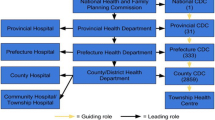Abstract
Sentinel practice networks have been established in many European countries to monitor disease incidence in the community. To demonstrate the value of sentinel networks an international study on the incidence of chicken pox has been undertaken. Chickenpox was chosen as an acute condition for which incidence data are important to the determination of health policy on vaccine use. The project examined the incidence of chickenpox reported in sentinel networks in England and Wales, the Netherlands, Portugal and Spain (two regional networks) in January–June 2000 and the potential underestimate from patients who did not consult. An investigation of secondary household contact cases was undertaken. Reported incidence of chickenpox (all ages) in England and Wales was 25 per 10,000, in the Netherlands 13 per 10,000, in Portugal 21 per 10,000, in Spain Castilla y Leon 27 per 10,000 and in Spain Basque 55 per 10,000. Analysis of secondary contact cases suggested underestimation of incidence between 2.4% in Spain Castilla y Leon and 32.2% in The Netherlands. There was a trend towards incidence at an earlier age in England and Wales and in the Netherlands compared with Portugal and Spain. Whilst there was little problem in reliably identifying the number of incident cases in the recording networks and relating the non-consulting contact cases to them, the security of the denominator remains a problem where networks are comprised of differing categories of health care provider. It is essential that numerator and denominator information are made available specifically for each category.
Similar content being viewed by others
References
Official J Eur Communities July 22, 1997 No. L 193/1-10.
Fleming DM. The role of research networks in primary care. Eur J Gen Prac 1998; 4: 96–99.
Fairley CK, Miller E. Varicella–Zoster virus epidemiology – a changing scene? J Infect Dis 1996; 174(suppl 3): S314–S319.
Enders G, Miller E, Cradock-Watson J, Bolley I, Ridehalgh M. Consequences of varicella and herpes zoster in pregnancy: Prospective study of 1739 cases. Lancet 1994; 343: 1548–1551.
Meyers JD. Congenital varicella in term infants: Risk reconsidered. J Infect Dis 1974; 129: 215–217.
Feldman S, Hughes WT, Daniel CB. Varicella in children with cancer: Seventy-seven cases. Pediatrics 1975; 56: 388–397.
Webster RG. Immunity to in.uenza in the elderly. Vaccine 2000; 18: 1485–1494.
Ross AM, Fleming DM. Chickenpox increasingly affects pre-school children. Commun Dis Public Health 2000; 3: 213–215.
Bramley JC, Jones IG. Epidemiology of chickenpox in Scotland: 1981–1998. Commun Dis Public Health 2000; 3: 282–287.
Socan M, Kraigher A, Pahor. Epidemiology of varicella in Slovenia over a twenty-year period (1979– 1998). Epidemiol Infect 2001; 126(2): 279–283.
Brisson M, Edmunds WJ, Law B, et al. Epidemiology of varicella zoster infection in Canada and the United Kingdom. Epidemiol Infect 2001; 127: 305–314.
International Classification of Primary Care ICPC-2. 2nd ed. WONCA International Classification Committee. Oxford University Press, 1998.
Author information
Authors and Affiliations
Rights and permissions
About this article
Cite this article
Fleming, D., Schellevis, F., Falcao, I. et al. The incidence of chickenpox in the community. Eur J Epidemiol 17, 1023–1027 (2001). https://doi.org/10.1023/A:1020066806544
Issue Date:
DOI: https://doi.org/10.1023/A:1020066806544




